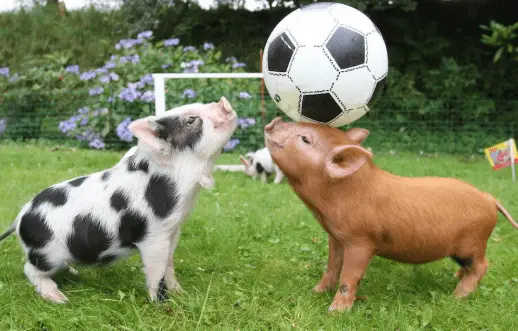Pigs are highly intelligent creatures and are easily bored, so there is always a need to keep them entertained. There are a lot of ways to keep your pig entertained.
There are also a lot of tools available to keep them mentally and physically active. The great thing about entertaining a pig is that aside from the easy access to tools and toys you can buy from stores, there is also a bunch of other things lying around your home that could prove to be useful.
Keeping your pig busy and entertained is not just about doing it for the sake of it. Training your pig to do tricks, for example, is not just for the sake of showing your pig off and telling your friends how cute it is. There is a deeper purpose for it.

Why It’s Important to Keep Pigs Entertained
It can do a lot for your pig’s behavior, for example. Pigs that are bored and lonely become restless, and eventually, unruly. It will become destructive and aggressive as it tries to handle things on its own and find ways to cater to its natural instincts.
By keeping your pig entertained, you allow it to go back to its natural instincts the safest and most productive way possible.
Mental and physical stimulation also does wonders for a pig’s overall emotional state. The more active a pig is, the happier it becomes. This makes your pig even healthier from a holistic point of view.
10 Ways to Keep Your Pig Entertained
- Hanging Treats
You can hang treats from branches, posts, and other areas around the area. You can put the treats inside those webbed dog balls that you can buy from the pet store.
You can also improvise and place the treats inside plastic bottles. This can add a certain level of difficulty as your pig tries to tip it over so that the treats inside would fall out.
The great thing about hanging treats is the physical activity involved. Not only would your pigs have to figure out how to reach those treats and make them come out of the container, they would also have to stretch their bodies out a little bit to get what they want.
- Rolling Treats
Here’s another activity that mixes physical and mental stimulation.
You can use any water jug or juice bottle. Drill holes around it, then fill it up with oats. You can also use other treats cut up into small pieces. It all depends on how big those holes are.
Then, let your pig run around the yard with the bottle. The more the pig lets the bottle roll around, the more treats it gets out of it!
You can also go for other rolling toys, like balls.
Add some difficulty by putting less holes on those rolling toys. Having too many holes will mean that it’s easy for the treats inside to come out. Make sure you also match the side of your treats to the size of the holes. When you make it too easy for them, the activity will get too boring too soon.
- Kiddie Pool
Pools are great especially in the summer. Not only will a pool keep your pig preoccupied, it will be a great way for your pig to stay cool as well.
You have two options when using kiddie pools — let the treats float, or let the treats sink.
A lot of vegetables would float in water. It would be fun for your pig to just float (or walk depending on the depth) around trying to catch these floating treats. The more your pig splashes around, the more those treats will float out of reach. This makes it a great way to teach your pig control.
Pigs also enjoy diving around, so you can also use toys and treats that sink to the bottom of the pool.
Note that pigs will not feel comfortable sliding around the pool, so inflatable pools are a better choice compared to hard plastic pools. If all you have is the latter, you can use rubber mats with suction cups to keep your pig from slipping and sliding around.
- Sand Pits
Remember that pigs are natural foragers. This means that they love digging their snouts anywhere, trying to find whatever great finds are in store for them.
This makes sand pits and sand boxes perfect for them.
Hide random treats under the sand. You can put anything from Cheerios to popcorn. Just make sure the sand does not cling to the treat as the pigs might end up eating them as well. Because of this, using treats like bits of apples will not be a good idea because the sand will stick to its watery texture.
Pigs have an amazing sense of smell, so you won’t even have to worry about closely guiding your pig through the sand. As long as there’s something underneath all that sand that smells good, your pig is sure to find it.
- Rooting Boxes
If you’d rather have your pig give way to its foraging instincts indoors but do not want it to start wrecking your stuff, you can create your own rooting boxes.
Just imagine a ball pit, but with a lot more goodies that a pig would enjoy inside it. That’s exactly what a rooting box is.
Yup, this means that when it gets too cold to play in the mini pool outdoors, you can use the same pool as an indoor rooting box. You can also innovate and make a box or pool using cardboard and wood.
What do you put inside your rooting box?
Anything!
You can put balls, crumpled paper, rocks, stuffed animals, blankets, and anything else your pig can sift through. Don’t worry about whether your pigs would enjoy the stuff in there or not. The act of foraging through that entire pile would be enough to tickle their fancy.
Just to stay on the safe side, make sure you put things that are safe and appropriate for your pig’s size. Don’t put anything that could potentially choke your pig. Don’t put anything sharp in there, either.
- Treat Fabrics
Here’s a great way to check your pig’s ability to solve puzzles.
You can use towels or any kind of fabric you have lying around the house.
Just loosely tie random treats into the fabric and see how your pig goes through the knots. Just make sure those knots aren’t too tight, otherwise, you might end up frustrating your pig. It might end up wrecking the fabric instead of untying the knot.
You can also just dips the towels in coconut oil, then tie them into knots. The smell will attract your pig, and would keep them interested until the knots are untied.
- Food Hunt
As mentioned earlier, pigs are natural foragers. So you can just imagine what kind of fulfillment your pig will feel if you have it go through a scavenger hunt of sorts.
Leave treats around an open area for your pig to find. Leave some of them exposed and easily seen, then place a few in hiding. You can put a tomato inside a bucket, for instance. You can also hide a bit of apple under a piece of fabric in the grass.
Again, you don’t have to worry about having to guide the pig through the hunt. Its nose will be its own guide. Once it sees all the visible treats, it will still smell more treats and will realize that there’s more to be found, but in hidden areas this time.
- Pet Puzzles
Although puzzles meant specifically for pigs aren’t that widespread yet, puzzles designed for dogs will yield the same results for pigs. It would even be interesting to compare how well a pig completes puzzles meant for dogs, knowing that some studies show pigs as having higher intellect than dogs.
Aside from the usual treat balls, there are hide and slide puzzles that reveal treats when the puzzle is solved. There are also flip toys and twist toys that will challenge your pig’s sharp mind and reward them afterwards.
- Mud Pit
So many pig parents ask whether their pig really needs a mud hole. The answer is yes, they need it more than you’ll ever know.
Letting your pig wallow in mud is a pig’s idea of a human’s afternoon dip in the pool. It’s fun, it’s relaxing, and it’s highly invigorating for them.
Plus, mud does a lot of wonders for your pig. It keeps them cool, especially since they do not have working sweat glands and are unable to cool themselves off with perspiration the same way humans do.
The mud also protects the pig’s skin from insects and parasites, as well as from the harsh rays of the sun.
- Skills and Tricks Training
When it comes to pigs, “entertaining” them could also mean teaching them something new. Knowing how intelligent pigs are, training will not seem like work to them — they would actually consider it as fun.
There are a lot of tricks your pig can learn. Some of them could be as simple as following commands like sit, stay, crawl, bow, or shake hands.
Treats, both food and non-food, are a huge help when it comes to pig training. You can give them bits of apple or carrots when they do a trick right. Eventually, when they’ve mastered a trick and are just practicing for the sake of remembering them, you can switch to non-food rewards like a belly rub or a pat on the head.
Related Questions
Do pigs chew on things?
Pigs chew on anything they find, especially when they have not been trained not to do so. This is why it is important to create the right kind of living environment when you decide to adopt a pet pig. Give them their own toys and other treats that they can nibble on. Give them the right kind of training as well so that they’ll know that chewing on your rugs and walls is not good.
Why does a pig wag its tail?
Just like dogs, pigs also wag their tails when they are feeling happy.
Watch out for signs like this to find out whether your pig is emotionally and physically well. If your pig stops wagging its tail and start looking sullen, it may be time to check if it is sick, or if it needs additional activities that would keep it entertained.
Do pigs like to be held?
Pigs usually don’t like being picked up or held. But when it starts to trust you, you can start being more affectionate with it. You can give it belly rubs, or you can cuddle with it.
